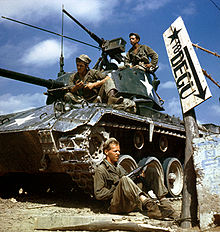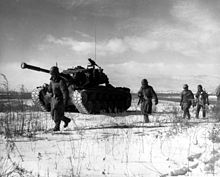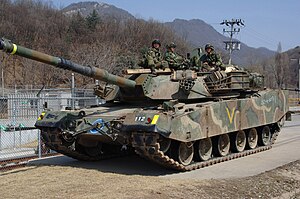Tanks of South Korea
The history and development of the
Overview

History of the South Korean army
Despite the initial plan of a unified Korea in the 1943 Cairo Declaration, escalating Cold War antagonism between the Soviet Union and the United States eventually led to the establishment of separate governments, each with its own ideology, leading to Korea's division into two political entities in 1948: North Korea and South Korea. In the North, a former anti-Japanese guerrilla and communist activist, Kim Il Sung gained power through Soviet support. In the South, elections supervised by the United Nations were held, a Republic of Korea was declared, and Syngman Rhee inaugurated as its first president. In December, the UN General Assembly declared this "a lawful government" and "the only such government in Korea."[1]


The United States engaged in the decolonization of Korea (mainly in the South, with the Soviet Union engaged in North Korea) from Japan after World War II. After three years of military administration by the United States, the South Korean government was established. Syngman Rhee was an anti-Communist, pro-capitalist autocrat that wanted an unified Korea under his rule. He consistently pleaded to the United States for weapons, armor, and warplanes but was denied repeatedly. The state of the newly established South Korean Army was pitiful and meager. Short on heavy weapons, tanks, warplanes, and sometimes even basic small arms, South Korean troops were largely ill disciplined, rough, and incompetent due to not enough funding and training from being recently established. When North Korea had finished preparations for an unification war (large scale mobilization drills, more robust economy than South Korea, centralized rule under Kim Il-sung, stock up of weaponry from the Soviet Union and soon to be Chinese Koreans repatriating from China to bolster the North Korean military from either 50% to 100% of its numbers in 1950), border troops were allowed to provoke South Korea's border troops. A few days before the outbreak of the Korean Civil War, South Korean troops attacked in retaliation for a provocation. North Korea utilized its readiness state to muster its forces within 3 days. On June 25, 1950, North Korea invaded South Korea, sparking the Korean War, the Cold War's first major conflict that continued until 1953. When the North Koreans invaded South Korea in June 1950, using T-34s, the South Koreans had no armor of their own so had to retreat in the face of North Korean tanks. North Korean troops were better trained, had better morale, were versed in guerrilla penetration attack tactics. North Korea nearly reunified the entirety of the Korean Peninsula. Soon after the invasion of South Korea, the United Nations voted to support the South Koreans. With the Korean War so closely following on the heels of World War II, many of the top tanks used in World War II were also utilized during the Korean War. The first tanks to be used by UN forces in South Korea were American M24 Chaffee light tanks, which were also used during the Second World War. They were sent to South Korea from Japanese army bases. While the Chaffee was useful for infantry support, it could not stand up to a T-34.


Upon the onset of the Korean War, U.S. forces were sent to defend South Korea against invasion by North Korea and later China. At the time, the Soviet Union had boycotted the United Nations (UN), thus forfeiting their veto rights. This allowed the UN to intervene when it became apparent that the superior North Korean forces would unify the entire country. The North Korea tanks confronted a tankless ROK Army armed with few modern anti-tank weapons,[2] including American World War II–model 2.36 in (60 mm) M9 bazookas, effective only against the 45 mm (1.8 in) side armor of the T-34-85 tank. Under-equipped ROK Army border units used American 105 mm M101 howitzers as anti-tank guns to stop the tanks heading the KPA columns, firing high-explosive anti-tank (HEAT) ammunition over open sights to good effect. At war's start, the ROK Army had 91 howitzers, but lost most to the invaders.[3]
Countering the initial combat imbalance, the UN Command reinforcement matériel included heavier US

In the
The heavier M26 Pershing was deemed unsatisfactory due to its inferior mobility, and in November, 1949, the upgraded M26 received a new power plant and a main gun with bore evacuator, and the M46 Patton designation. Less than a thousand were upgraded to M46 standard.

On 8 August 1950 the first M46 Pattons landed in South Korea. The tank proved superior to the much lighter North Korean T-34-85, which were encountered in relatively small numbers. By the end of 1950, 200 M46 Pattons had been fielded, forming about 15% of US tank strength in Korea; the balance of 1,326 tanks shipped to Korea during 1950 included 679 M4A3 Shermans, 309 M26 Pershings, and 138 M24 Chaffee light tanks.[5] Subsequent shipments of M46 and M46A1 Pattons allowed all remaining M26 Pershings to be withdrawn during 1951, and most Sherman equipped units were also reequipped.[6]
By 1953 the M24 Chaffee's were completely replaced by the new M41 tank in the United States Army which was later designated the M41 Walker Bulldog. The M41 was an agile and well armed. The Walker Bulldog was rushed to the battlefield but saw limited combat.

British tanks, the
Unlike in the Second World War (1939–45), in which the tank proved a decisive weapon, the Korean War featured few large-scale tank battles. The mountainous, heavily forested terrain prevented large masses of tanks from maneuvering. After huge advances on both sides, and massive losses among Korean civilians in both the north and the south, the war eventually reached a stalemate. The 1953 armistice, never signed by South Korea, split the peninsula along the demilitarized zone near the original demarcation line. No peace treaty was ever signed, resulting in the two countries remaining technically at war.

The
Organization of South Korean Army armored forces



Beginning in 1945, the country which became South Korea was controlled by American forces and the remaining IJA forces which remained in place to assist until they were repatriated to Japan.
At the end of World War II, the South Korean Army was formed but with no tanks until the Korean War, and at the beginning counted only on equipment composed of very few armored vehicles and even fewer tanks. The South Korean Army would receive medium battle tanks M4A3E8 "Easy Eight" variant of Sherman tanks, and M47 and M48 Patton series tanks from the United States. These tanks were an important modernization of South Korea armored firepower.
The
Modern South Korean armor: present


By the 1970s, the Republic of Korea was desperately in need of additional main battle tanks. M4A3E8 "Easy Eight" variant of Sherman tanks, dating back to World War II, had been retired from service by the Republic of Korea Army, and the backbone of the South Korean armor was formed up of M47 and M48 Patton tanks. Meanwhile, North Koreans had both numerical and technological advantages over the South Korean armor with their T-62 main battle tanks.
At first, attempts were made to obtain the United States'



XK1 tanks are also equipped with a hybrid suspension system consisting of hydropneumatic system on road wheels 1, 2 and 6, while 3, 4 and 5 are equipped with torsion bars, a feature not present on the XM1, granting the XK1 greater stability and ability to elevate and depress the main gun nearly twice as much as tanks equipped with torsion bars alone (+20 to -9.7 degrees for the XK1 versus +10 to -5 for the XM1).
The development of the vehicle was completed in 1983, with a prototype being delivered to the South Korean government in the same year. After the production of approximately 450 K1s, the Gunner's Primary Sights (GPS) designed by Hughes was replaced by the Gunner's Primary Tank Thermal Sights (GPTTS) by
South Korea was given 33 T-80U and 2 T-80UK tanks to pay Russian debts incurred during the days of the Soviet Union. The tanks came in three batches; the first consisted of six T-80Us in 1996, followed by 27 T-80Us in 1997, and finally two T-80UKs in 2005.
Today the
The replacement for the K1 MBT is known as the K2 Black Panther (Korean: 흑표), fitted with a 1,500 hp (1,100 kW) water-cooled Diesel engine, 120 mm/L55 main gun, and coaxial machine guns. The K2 also features radar equipment as well as all-bearing
. The first batch of K2s was delivered to the ROK military in 2014.South Korean armor outside of South Korea

From time to time, South Korea has sent its troops overseas to assist in international conflicts. It has participated in a number of international conflicts since the end of the Korean War. South Korea dispatched 325,517 troops to fight alongside US, Australian,
List of armored equipment of the Republic of Korea Armed Forces

Tanks
- M4A3E8 (retired)
- M47 Patton (retired)
- M48A3K & M48A5K MBTs
- T-80U & T-80UK MBTs
- K1 & K1A1 MBTs
- K2 Black Panther MBT
Armored vehicles
- M113
- K200 & K200A1 series
- BMP-3
- K532
- KM900
- Doosan Barracuda
- K21 KNIFV
- KAAV7A1
See also
- History of the tank
- Tanks in World War I
- List of interwar armoured fighting vehicles
- Tanks in World War II
- Comparison of early World War II tanks
- Tank classification
- List of military vehicles
- List of main battle tanks by country
References
- ^ "195 (III) The problem of the independence of Korea Archived 2013-10-23 at the Wayback Machine", December 12, 1948, Resolutions Adopted by the General Assembly During its Third Session, p. 25.
- ISBN 978-0688095130.
- ISBN 978-0070235809.
- ^ Stokesbury 1990, pp. 182–184.
- ISBN 1-84176-202-4pp.39-40
- ISBN 1-84176-621-6pp.52,75-86
- ^ "OPLAN 5027 Major Theater War – West". Archived from the original on 2013-11-02.
- ^ "Zaytun Division official website". Retrieved February 17, 2009.[dead link]
External links
- Republic of Korea Military Guide (globalsecurity.org)
- Republic of Korea Ministry of National Defense (ROKMND) (Korean / [ English])
- K1A1 Main Battle Tank Details
- K1A1 Tank Overview at Rotem Website (Best viewed in Internet Explorer).
- Type 88 K1 Main Battle Tank at GlobalSecurity.org
- K1A1 Main Battle Tank at GlobalSecurity.org
- Photos at GlobalSecurity.org
- K1-K1A1 MBT at Armour.ws
